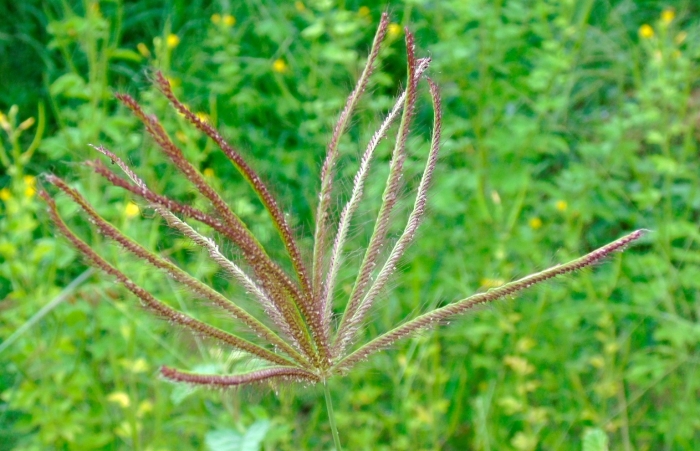Rhodes Grass
(Chloris gayana)
Rhodes Grass (Chloris gayana)
/
/

Francisco Farriols Sarabia
CC BY 4.0
Image By:
Francisco Farriols Sarabia
Recorded By:
Copyright:
CC BY 4.0
Copyright Notice:
Photo by: Francisco Farriols Sarabia | License Type: CC BY 4.0 | License URL: http://creativecommons.org/licenses/by/4.0/ | Rights Holder: Francisco Farriols Sarabia | Publisher: iNaturalist | Date Created: 2016-09-06T09:58:10-07:00 |






















Estimated Native Range
Summary
Chloris gayana, commonly known as Rhodes grass, is a fast-growing perennial grass native to the savannas and open grasslands of Africa. It has been naturalized in many tropical and subtropical regions around the world. This species typically reaches up to 10 feet in height and spreads via stolons, forming dense tufts and extensive stands. The grass has a deep root system, which makes it drought-tolerant and well-suited to arid environments.
Rhodes grass is valued for its use as a forage crop due to its high productivity and palatability to livestock. It is also used for soil erosion control and as a turf grass in some regions. In cultivation, it prefers full sun and can tolerate a range of soil types, provided they are well-drained. It requires moderate watering, particularly in areas with low rainfall. However, its aggressive growth can make it invasive in some areas, outcompeting native vegetation and altering ecosystems. Gardeners should be cautious and check local regulations before planting Rhodes grass outside its native range.CC BY-SA 4.0
Rhodes grass is valued for its use as a forage crop due to its high productivity and palatability to livestock. It is also used for soil erosion control and as a turf grass in some regions. In cultivation, it prefers full sun and can tolerate a range of soil types, provided they are well-drained. It requires moderate watering, particularly in areas with low rainfall. However, its aggressive growth can make it invasive in some areas, outcompeting native vegetation and altering ecosystems. Gardeners should be cautious and check local regulations before planting Rhodes grass outside its native range.CC BY-SA 4.0
Plant Description
- Plant Type: Grass
- Height: 1-4.9 feet
- Width: 2-5 feet
- Growth Rate: Moderate, Rapid
- Flower Color: N/A
- Flowering Season: Spring, Summer
- Leaf Retention: Deciduous
Growth Requirements
- Sun: Full Sun
- Water: Low
- Drainage: Medium
Common Uses
Drought Tolerant, Erosion Control, Low Maintenance
Natural Habitat
Native to the savannas and open grasslands of Africa
Other Names
Common Names: Rhodes Grass, Feather Windmill Grass, Fei Zhou Hu Wei Cao
Scientific Names: , Chloris gayana, Chloris abyssinica, Chloris abyssinica, Chloris gayana f. genuina, Chloris gayana f. oligostachya, Chloris gayana f. oligostachys, Chloris gayana subsp. oligostachya, Chloris gayana subsp. oligostachys, Chloris glabrata
GBIF Accepted Name: